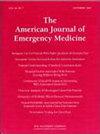Rivastigmine as an alternative treatment for anticholinergic toxidrome in light of the physostigmine shortage: A case series
IF 2.7
3区 医学
Q1 EMERGENCY MEDICINE
引用次数: 0
Abstract
Introduction
Physostigmine is an acetylcholinesterase inhibitor historically used for the treatment of anticholinergic toxicity. Supply of physostigmine has been limited as the US manufacturer recently stopped production. Rivastigmine, a long-acting acetylcholinesterase inhibitor FDA-approved for the treatment of Alzheimer's and Parkinson's disease dementia, is a potential alternative to physostigmine. There are few case reports and case series demonstrating the safe and effective use of both oral and transdermal rivastigmine for anticholinergic toxicity. The objective of this study was to describe the effects of rivastigmine in patients with anticholinergic toxicity.
Methods
A retrospective case review of patients that received rivastigmine at a metropolitan level-1 trauma center between January 2022–January 2024 resulted in 12 patients who met inclusion/exclusion criteria and were included in this analysis. Data collected included xenobiotic ingested, co-ingestions, symptoms on presentation, rivastigmine capsule and/or patch administration, adverse events, benzodiazepine administration, disposition, ICU and hospital length of stay.
Results
Of 12 patients, 9 had co-ingestions of other prescription or over-the-counter medications. 2 of 12 patients received both rivastigmine patches and capsules, 8 of 12 received only patches, and 2 of 12 received only capsules. The average dose of rivastigmine patches was 8.66 mg and average capsule dose was 6 mg. None of the patients experienced adverse effects from rivastigmine use. Length of stay ranged from 2 to 9 days with an average of 3.6 days.
Conclusion
Our study shows that rivastigmine is a reasonable alternative to physostigmine based on the lack of adverse events reported and symptom relief.
利瓦斯汀作为抗胆碱能性氧化症的替代治疗:一个病例系列
蛇的明是一种乙酰胆碱酯酶抑制剂,历来用于治疗抗胆碱能毒性。由于美国制造商最近停止了生产,毒豆碱的供应受到限制。利瓦斯蒂明是一种长效乙酰胆碱酯酶抑制剂,fda批准用于治疗阿尔茨海默氏症和帕金森病痴呆,是一种潜在的替代药。很少有病例报告和病例系列证明口服和透皮使用利瓦斯汀治疗抗胆碱能毒性是安全有效的。本研究的目的是描述利瓦斯汀在抗胆碱能毒性患者中的作用。方法回顾性分析2022年1月至2024年1月期间在大都会一级创伤中心接受利瓦斯替明治疗的患者,12例患者符合纳入/排除标准,并纳入本分析。收集的数据包括外源药物摄入、共摄入、出现时的症状、利瓦斯汀胶囊和/或贴片的使用、不良事件、苯二氮卓类药物的使用、处置、ICU和住院时间。结果12例患者中,9例同时服用其他处方药或非处方药。12例患者中2例同时使用了伐斯汀贴片和胶囊,8例仅使用了贴片,2例仅使用了胶囊。利瓦斯汀贴剂平均剂量为8.66 mg,胶囊平均剂量为6 mg。没有患者因使用利瓦斯汀而出现不良反应。住院时间为2至9天,平均3.6天。结论本研究表明,在无不良事件报告和症状缓解的基础上,利瓦斯汀是一种合理的替代药。
本文章由计算机程序翻译,如有差异,请以英文原文为准。
求助全文
约1分钟内获得全文
求助全文
来源期刊
CiteScore
6.00
自引率
5.60%
发文量
730
审稿时长
42 days
期刊介绍:
A distinctive blend of practicality and scholarliness makes the American Journal of Emergency Medicine a key source for information on emergency medical care. Covering all activities concerned with emergency medicine, it is the journal to turn to for information to help increase the ability to understand, recognize and treat emergency conditions. Issues contain clinical articles, case reports, review articles, editorials, international notes, book reviews and more.

 求助内容:
求助内容: 应助结果提醒方式:
应助结果提醒方式:


